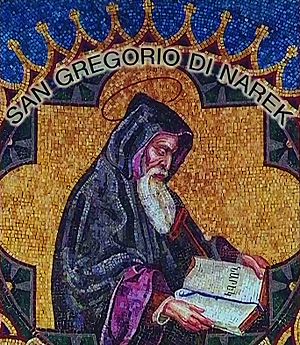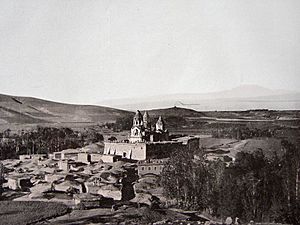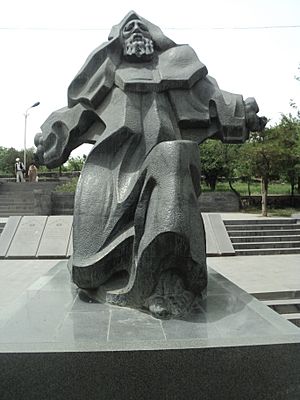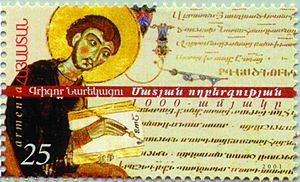Gregory of Narek facts for kids
Quick facts for kids SaintGregory of Narek |
|
|---|---|

Portrait of Gregory from an 1173 manuscript from Cilician Armenia
|
|
| Doctor of the Church | |
| Born | c. 945–951 |
| Residence | Narek Monastery, Kingdom of Vaspurakan |
| Died | c. 1003–1011 (aged ≈60) |
| Venerated in | |
| Major shrine | Chapel-Mausoleum at Narek Monastery |
| Feast |
|
| Influences | Neoplatonism, Pseudo-Dionysius the Areopagite |
| Influenced | All Armenian literature, especially verse: Nerses Shnorhali, Sayat-Nova, Yeghishe Charents |
| Major works | Book of Lamentations (Narek) |
Grigor Narekatsi (Armenian: Գրիգոր Նարեկացի), also known as Gregory of Narek, was an important Armenian poet, monk, and thinker who lived around 950 to 1003/1011. He is honored as a saint in both the Armenian Apostolic Church and the Catholic Church. In 2015, Pope Francis gave him the special title of Doctor of the Church. This title is given to saints who have made a big impact on Christian teachings.
Gregory was the son of a bishop. He grew up and was trained at the Narekavank monastery, which was located on the southern shores of Lake Van (in what is now Turkey). Experts believe Gregory is the most loved and important religious and literary figure in Armenian Christian history.
He is most famous for his book, Book of Lamentations. This book is a very important piece of spiritual writing. It is a book of prayers and confessions that many Armenian families keep in their homes. Gregory's writings have inspired many Armenian writers and have greatly influenced Armenian literature over the centuries.
Contents
Life and Times of Gregory
Gregory was born between 945 and 951 and passed away between 1003 and 1011. He lived in the Kingdom of Vaspurakan, an Armenian kingdom known for its high level of culture. This region, around Lake Van, is often called "the birthplace of Armenian civilization."
We don't know many details about his daily life. He was born in a village near Lake Van. His father, Khosrov Andzevatsi, became a bishop. Gregory and his older brother, Hovhannes, were sent to the Narekavank monastery. There, his great-uncle, Anania Narekatsi, who was a famous scholar and the monastery's founder, taught them. Gregory grew up in a very intellectual and religious environment. He became a priest in 977 and taught theology at the monastery school until he died.
Some scholars wonder if Gregory lived a very quiet life, away from the world. Others believe he knew a lot about the world around him, including both ordinary people and powerful leaders. They think he understood the complex challenges of his time.
Gregory was buried inside the Narek monastery. A small chapel was built over his tomb. Sadly, the monastery was later destroyed, and a mosque was built in its place.
Gregory's Writings
The Book of Lamentations (Narek)
The Book of Lamentations (Classical Armenian: Մատեան ողբերգութեան), often simply called Narek, is seen as Gregory's greatest work. He finished it near the end of his life, around 1002–1003. The book is like a long, personal poem, a conversation with God from his heart. It has 95 chapters and more than 10,000 lines. Most chapters are titled "Words unto God from the Depths of My Heart." These chapters are prayers or sad poems, all speaking to God.
The main idea of the book is Gregory's struggle to be perfect, as Jesus taught, while knowing he can't be. It also explores the idea of God's amazing love and forgiveness, which makes up for human weaknesses.
This book is considered a masterpiece of Christian spiritual writing. It is the "most beloved work of Armenian literature." For centuries, Armenian families have kept the Narek in their homes. Many Armenians believe it has special, even miraculous, powers. For example, some people read a passage from it to help someone who is sick.
The first full version of the book was printed in 1673 in France. It has been translated into many languages, including English, Russian, and French.
Other Works
Gregory also wrote other important works. He wrote a commentary on parts of the Book of Job from the Bible. He also wrote hymns, praises for holy figures, and many chants and prayers that are still sung in Armenian churches today.
He wrote special praises for Mary, the mother of Jesus. In these writings, he talked about Mary's special qualities, like her bodily Assumption into heaven and her perpetual virginity.
Gregory also wrote about the True Cross, a holy relic. He used these writings to defend traditional Christian beliefs against groups like the Tondrakians, who had different ideas. He also wrote a praise for Jacob of Nisibis, an important bishop from the fourth century.
He also wrote about two dozen tagher (odes or songs) and spiritual songs called gandz. These are some of the earliest religious poems in Armenian literature. Gregory even composed music for his odes.
Gregory's Ideas
Gregory's main idea was that eternal salvation comes from faith and God's grace, not just from the church. This idea is similar to what some Christian groups believed much later.
Gregory was sometimes suspected of having ideas similar to certain groups, like the Tondrakians, who were seen as heretics. However, Gregory wrote against the Tondrakians in the 980s. In his Book of Lamentations, he strongly supported the importance of church practices like baptism and communion, which the Tondrakians did not value as much.
His ideas were also influenced by Neoplatonism, a type of philosophy that combines ancient Greek ideas with Christian thought. This included ideas about becoming more like God through spiritual cleansing.
Many scholars have compared Gregory's writing style and ideas to those of famous writers like Augustine of Hippo (who wrote Confessions), Rumi (a Sufi poet), and even later writers like Fyodor Dostoyevsky. One scholar said Gregory is like a mix of Augustine and James Joyce, but also has the simple faith of early Christian monks.
How Gregory is Remembered
Gregory was the first major Armenian lyrical poet. He is considered the most beloved person in Armenian Christianity. Many experts call him the "most significant poet of the whole Armenian religious tradition." He is also seen as one of the three great visionaries of Armenian culture, along with Mesrop Mashtots and Yeghishe Charents.
Some scholars believe Gregory of Narek should be known as one of the greatest mystical writers of the Middle Ages. They compare him to other famous figures like Augustine of Hippo, Dante Alighieri, and Thomas à Kempis. One critic even compared his genius to that of William Shakespeare and Miguel de Cervantes.
Gregory greatly shaped and enriched the Classical Armenian language through his lively and unique writing style. It is believed that he created more than 2,500 new Armenian words. For example, he might have created words like lusankar (portrait or image) and odachu (pilot).
Some Criticisms
Not everyone has praised Gregory's work. A writer named Shahan Shahnour, in his novel Retreat Without Song (1929), had a character who called the Book of Lamentations "the most immoral, unhealthy, poisonous book." This character felt it made Armenians weak as a nation.
Another Armenian writer, Paruyr Sevak, famously said that Armenians have "kissed" the Narek more than they have "read" it, meaning they respected it without always understanding its deep meaning.
Veneration and Honor

In Armenian Churches
Gregory of Narek is a saint in both the Armenian Apostolic and Armenian Catholic churches. The Armenian Apostolic Church celebrates his feast day in October, during the Feast of the Holy Translators. This day honors him and other important Armenian scholars. The exact date he became a saint is not known, but he was already recognized as one by 1173.
A special relic of Gregory is kept at the Mother See of Holy Etchmiadzin, a very important place for the Armenian Church. Several new churches in Armenia have been named after him. There is also a St. Gregory of Narek Armenian Apostolic Church in Ohio, USA.
In the Catholic Church

Pope John Paul II called Gregory "one of the outstanding glories of Armenia" in 1987. He also mentioned Gregory's prayers in the Catechism of the Catholic Church.
On February 23, 2015, Pope Francis officially declared Gregory of Narek a Doctor of the Church. This was a very important event. On April 12, 2015, during a special Mass at St. Peter's Basilica, Pope Francis made the announcement. Leaders of the Armenian Church and the President of Armenia were present. Pope Francis later said he wanted to bring more attention to Gregory by giving him this title.
Gregory is the 36th Doctor of the Church and the first Armenian to receive this honor. He is also unique because he was not in full communion with the Catholic Church during his lifetime. The Vatican City state even issued a postage stamp to celebrate this event in 2015. In 2018, a two-meter-high bronze statue of Gregory was placed in the Vatican Gardens.
Since 2021, the Catholic Church celebrates an optional memorial day for him on February 27.
Gregory's Lasting Impact
Influence on Literature
Gregory had a huge impact on almost all Armenian literature that came after him. Some scholars say his influence on Armenian Christian literature is as great as Homer's on Greek literature or Dante's on Italian literature.
He inspired many important Armenian poets, both from the Middle Ages and modern times. These include Nerses Shnorhali, Sayat-Nova, and Yeghishe Charents. Charents praised Gregory in his poems, calling him a genius. Paruyr Sevak described the Book of Lamentations as a "temple of poetry" that time cannot destroy.
Tributes to Gregory
The name Narek is very popular for boys in Armenia. In 2018, it was the second most common name given to baby boys. This popularity comes from the village and monastery of Narek, and especially from Gregory of Narek and his famous Book of Lamentations. The village of Narek in Armenia was named after him in 1984.
The Narekatsi Professorship of Armenian Language and Culture at the University of California, Los Angeles (UCLA) is named in his honor. In Yerevan, Armenia, a public school and a medical center are also named after Gregory. He was featured on an Armenian postage stamp in 2001. The Naregatsi Art Institute, which promotes Armenian art, has centers in Yerevan and Shushi.
A statue of Gregory was put up in Yerevan in 2002. In 2010, a large stone resembling an old manuscript, with lines and images from the Book of Lamentations, was unveiled in a district of Yerevan.
The Soviet composer Alfred Schnittke even created music for a Russian translation of the Book of Lamentations in 1985.
|
See also
 In Spanish: Gregorio de Narek para niños
In Spanish: Gregorio de Narek para niños





